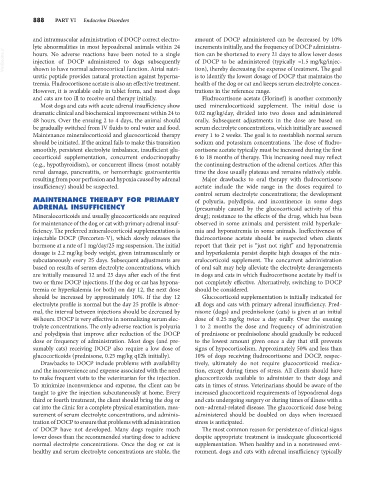Page 916 - Small Animal Internal Medicine, 6th Edition
P. 916
888 PART VI Endocrine Disorders
and intramuscular administration of DOCP correct electro- amount of DOCP administered can be decreased by 10%
lyte abnormalities in most hypoadrenal animals within 24 increments initially, and the frequency of DOCP administra-
VetBooks.ir hours. No adverse reactions have been noted to a single tion can be shortened to every 21 days to allow lower doses
of DOCP to be administered (typically ≈1.5 mg/kg/injec-
injection of DOCP administered to dogs subsequently
shown to have normal adrenocortical function. Atrial natri-
is to identify the lowest dosage of DOCP that maintains the
uretic peptide provides natural protection against hyperna- tion), thereby decreasing the expense of treatment. The goal
tremia. Fludrocortisone acetate is also an effective treatment. health of the dog or cat and keeps serum electrolyte concen-
However, it is available only in tablet form, and most dogs trations in the reference range.
and cats are too ill to receive oral therapy initially. Fludrocortisone acetate (Florinef) is another commonly
Most dogs and cats with acute adrenal insufficiency show used mineralocorticoid supplement. The initial dose is
dramatic clinical and biochemical improvement within 24 to 0.02 mg/kg/day, divided into two doses and administered
48 hours. Over the ensuing 2 to 4 days, the animal should orally. Subsequent adjustments in the dose are based on
be gradually switched from IV fluids to oral water and food. serum electrolyte concentrations, which initially are assessed
Maintenance mineralocorticoid and glucocorticoid therapy every 1 to 2 weeks. The goal is to reestablish normal serum
should be initiated. If the animal fails to make this transition sodium and potassium concentrations. The dose of fludro-
smoothly, persistent electrolyte imbalance, insufficient glu- cortisone acetate typically must be increased during the first
cocorticoid supplementation, concurrent endocrinopathy 6 to 18 months of therapy. This increasing need may reflect
(e.g., hypothyroidism), or concurrent illness (most notably the continuing destruction of the adrenal cortices. After this
renal damage, pancreatitis, or hemorrhagic gastroenteritis time the dose usually plateaus and remains relatively stable.
resulting from poor perfusion and hypoxia caused by adrenal Major drawbacks to oral therapy with fludrocortisone
insufficiency) should be suspected. acetate include the wide range in the doses required to
control serum electrolyte concentrations; the development
MAINTENANCE THERAPY FOR PRIMARY of polyuria, polydipsia, and incontinence in some dogs
ADRENAL INSUFFICIENCY (presumably caused by the glucocorticoid activity of this
Mineralocorticoids and usually glucocorticoids are required drug); resistance to the effects of the drug, which has been
for maintenance of the dog or cat with primary adrenal insuf- observed in some animals; and persistent mild hyperkale-
ficiency. The preferred mineralocorticoid supplementation is mia and hyponatremia in some animals. Ineffectiveness of
injectable DOCP (Percorten-V), which slowly releases the fludrocortisone acetate should be suspected when clients
hormone at a rate of 1 mg/day/25 mg suspension. The initial report that their pet is “just not right” and hyponatremia
dosage is 2.2 mg/kg body weight, given intramuscularly or and hyperkalemia persist despite high dosages of the min-
subcutaneously every 25 days. Subsequent adjustments are eralocorticoid supplement. The concurrent administration
based on results of serum electrolyte concentrations, which of oral salt may help alleviate the electrolyte derangements
are initially measured 12 and 25 days after each of the first in dogs and cats in which fludrocortisone acetate by itself is
two or three DOCP injections. If the dog or cat has hypona- not completely effective. Alternatively, switching to DOCP
tremia or hyperkalemia (or both) on day 12, the next dose should be considered.
should be increased by approximately 10%. If the day 12 Glucocorticoid supplementation is initially indicated for
electrolyte profile is normal but the day 25 profile is abnor- all dogs and cats with primary adrenal insufficiency. Pred-
mal, the interval between injections should be decreased by nisone (dogs) and prednisolone (cats) is given at an initial
48 hours. DOCP is very effective in normalizing serum elec- dose of 0.25 mg/kg twice a day orally. Over the ensuing
trolyte concentrations. The only adverse reaction is polyuria 1 to 2 months the dose and frequency of administration
and polydipsia that improve after reduction of the DOCP of prednisone or prednisolone should gradually be reduced
dose or frequency of administration. Most dogs (and pre- to the lowest amount given once a day that still prevents
sumably cats) receiving DOCP also require a low dose of signs of hypocortisolism. Approximately 50% and less than
glucocorticoids (prednisone, 0.25 mg/kg q12h initially). 10% of dogs receiving fludrocortisone and DOCP, respec-
Drawbacks to DOCP include problems with availability tively, ultimately do not require glucocorticoid medica-
and the inconvenience and expense associated with the need tion, except during times of stress. All clients should have
to make frequent visits to the veterinarian for the injection. glucocorticoids available to administer to their dogs and
To minimize inconvenience and expense, the client can be cats in times of stress. Veterinarians should be aware of the
taught to give the injection subcutaneously at home. Every increased glucocorticoid requirements of hypoadrenal dogs
third or fourth treatment, the client should bring the dog or and cats undergoing surgery or during times of illness with a
cat into the clinic for a complete physical examination, mea- non–adrenal-related disease. The glucocorticoid dose being
surement of serum electrolyte concentrations, and adminis- administered should be doubled on days when increased
tration of DOCP to ensure that problems with administration stress is anticipated.
of DOCP have not developed. Many dogs require much The most common reason for persistence of clinical signs
lower doses than the recommended starting dose to achieve despite appropriate treatment is inadequate glucocorticoid
normal electrolyte concentrations. Once the dog or cat is supplementation. When healthy and in a nonstressed envi-
healthy and serum electrolyte concentrations are stable, the ronment, dogs and cats with adrenal insufficiency typically

